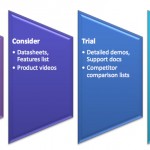2015 Digital Marketing Strategy Using Personalization
With personalisation becoming more available and more widely adopted, the prediction for 2015 is for 1 to 1 digital marketing to be on the increase. The more relevant content is to the end user, the more they are to interact with your business which leads to higher time on site, repeat visits, increased satisfaction which ultimately leads to higher profits.
1. Content Marketing Will be Bigger Than Ever
Content marketing will rule budgets priorities and customer attention!
When sitting down to create your own digital marketing calendar you will want to truly understand how the buying cycle works. Once you have determined where your contacts are in the buying cycle, you can then map content specific to their needs at that time.
There are three stages of the buying cycle:
- Awareness: Prospects have become aware that they have a need or a problem to solve and can likely become leads at this stage.
- Consideration: Leads have become aware that your product/service can likely solve their problem and are considering it as a solution.
- Decision: Leads are ready to make a purchase and are comparing vendors.
Creating content around the phase of the buying cycle is a key element to creating a successful digital marketing program. This is called Content Mapping. In fact, as small business owners become more digitally savvy, this personalization is what is going to set you apart.
2. Social Media Marketing Scommerce – Social media meets shopping
Personalization will earn you some serious cred amongst your customer
Social commerce is becoming a large driver of online shopping. User-generated content around shopping can have some major impacts. The first successful steps to push forward more sophisticated Scommerce were seen in 2014, for example with the introduction of Twitter Product Cards and innovative campaigns on Pinterest. We recently saw increased efforts to simplify the social network-driven buying process for online shoppers with both Twitter and Facebook pioneering the testing of “Buy” CTA buttons. The more relevant and tailored your social advertising is, the fewer users will feel commercialized.
Companies will zero in on their perfect customers: Enhanced social media data will help companies target messages to ideal buyers, resulting in higher conversions and efficient marketing budgets. Did you know, every day, Facebook processes about 500 time more data than the New York Stock Exchanges.
Social Media – The free lunch is over: Social media was, and still is, a free market. But as a marketer, that well has dried up. With so many ads and businesses posting on social media, your product is the needle in the haystack. Or even worse, a needle in a stack of needles. So it’s time to start spending a little on social advertising, and if you haven’t already, you’re behind the curve. According to eMarketer, digital ad spend worldwide is set to hit $137.53 billion by the end of this year. That’s a 14.8% increase from 2013, and it’s expected to continue to rise in 2015. It makes sense. In order to have your product stand out on social media, you need to invest to gain.
Social platforms are continuing to show the largest growth in advertising dollars as our eyes and ears are continuing to spend more and more time plugged into them. This also means that marketing teams will need to continue efforts to create valuable content and campaigns for these channels. Content optimized for these areas must be focused on visuals and get straight to the point – plan your communications accordingly!
3. Mobile Will Dominate: Master It
Mobile, Mobile, and then some more mobile
With mobile usage continuing well into 2015, focus has and will continue to shift from desktops and will be driven by mobile and tablet usage. This increase in mobile usage gives marketers more opportunities to target people especially outside of the 9 to 5 working hours. Not only are sites being built responsibly and with a rise on mobile apps but also companies content marketing plans continues to focus on handheld devices and how they want their information consumed.
Maribel Lopez, author of Right Time Experiences, says that we should watch for “contextual integrations” between our smart phone apps in 2015. Said differently, contextual integrations mean that the apps on our smart phones will begin to connect and work together. For example, we may see something like an “airline app that connects to Uber for airport transportation and traffic data to figure out when to leave.”
Mobile apps will become the gateway to personalized data: More than 268 billion expected downloads will make mobile apps a leading marketing tool, offering a rich stream of personalized data. Did you know that by 2017 consumers will provide data to more than 100 mobile apps and services everyday.

Google reports that 71 percent of in-store shoppers who use smartphones for online research say their device has become more important to their in-store experience. Retailer should think about using mobile apps as part of their marketing activities. The technological progress in terms of “geo-fencing” and “geo-targeting” will help them reach their customers with timely and highly contextual messages on a one-to-one basis. Geo-targeting is the practice of customizing an advertisement for a product or service to a specific market based on the geographic location of potential buyers.Geo-Fencing uses the global positioning system to outline geographical boundaries. When a person’s mobile device enters the boundaries, an email, text message or push notification is sent out. Considering a worldwide mobile penetration of 93%, major social networks are constantly improving their mobile presence. Social websites and apps being among the most used features on mobile.
We need a “mobile first” mentality when it comes to marketing today and how we do business in general. There are now more mobile, handheld devices on the planet than there are people, and that figure is rising at a rate five times faster than human population. No other man-made phenomenon has had this type of impact on our society, going from zero to 7.2 billion in just three decades.
4. Ad Retargeting Will Grow in Effectiveness
Increased targeting, segmentation and customization
Put away your one-to-many playbook and dig deeper into customization and personalization strategies to find the small, yet potentially profitable subsets of your market and niche offerings. Touching these customers will require data parsing to create the kind of one-to-one conversations for successful micro targeting.
Though it has been important for at least the past year, content and retarketing campaigns will continue to be broken down into smaller and smaller segments that will inevitably result in completely individualized content. As the targeting and tracking of potential clients and customers have become easier with technology, it will become ever more important for the messaging and visuals that prospects receive to be customized specifically to their needs and concerns. “Micro-targeting” will allow you to identify profitable niche subsets and allow you to deploy the most relevant strategies and content throughout the buying cycle.
5. SEO and Social Signals Will Become Even More Intertwined
An integrated approach to optimization will develop
Instead of separating marketing channels, companies will adopt a cohesive marketing strategy that integrates social media marketing, content creation, and SEO to enhance the overall customer experience. Search Engine Optimization (SEO) leads have an average close rate of 14.6%, while outbound leads (such as cold calls or print advertising) have an average close rate of 1.7%. Having your website optimized for SEO is a necessity heading into 2015. By having an SEO strategy in place, you can increase your leads and grow your business for next year.
Mobile-first SEO: Many reports, throughout 2014, have been published, indicating the rapid growth in mobile web traffic as against its traditional counterpart and that it will completely surpass the desktop traffic by 2015. This fundamental shift in the web user behavior has brought major implications on global search engine optimization practices. In a blog post published earlier this year, Google suggests that 4 in 5 consumers carry out local searches and over eighty percent of them do it on their mobile devices. Hence, in the New Year, the businesses and marketers will have to rethink their existing ‘desktop-centric’ SEO tactics and re-divert the emphasis on real-time mobile search algorithms. So, in 2015, to keep up with the expeditiously expanding mobile SEO space, make sure that your website is mobile-ready and is accessible to any device. Start working on building a dedicated mobile SEO plan right away!
Fragmented searches; Longer keywords: With the continuous introduction and evolution of different search platforms, mobile devices as well as applications, marketers cannot afford to rely on just the search engines on web browsers. On the other hand, as indicated by a Google fellow, nearly 20% of daily queries on the search engine are unique. Now, that’s some staggering figure. Also, instead of targeting one or two-word keywords or phrases, it might be more accurate and economical to focus optimization efforts on long-tail keywords. With the introduction of voice-enabled searches on mobile devices, strategically devised longer keywords will become more relevant and help catch the buying intent more accurately. So in 2015, prepare yourself and your brand to wield the power of long-tail keywords.
These are 5 of the many reasons why your marketing strategy for 2015 should be more focused online rather than off, accessible on a mobile level rather than a stationary desktop platform. When analyzing your marketing budget for 2015 and beyond, consider some things simply cannot be ignored, even if they are costly.
Where to start: If you don’t know who you’re talking to, you won’t know what to say. Committing to buyer persona development lets you deep dive into needs, lifestyle, and motivations of your buyers. The work is well worth the ability to construct more relevant content strategies throughout the buying cycle, post-purchase efforts, and account-based marketing activities.
If your marketing strategy is not designed to be used with the technology and trends in the twentieth century, then your business will become a part of the past rather than embracing the future. We hope these five digital marketing trends will help you get a jump start on your strategic planning for 2015. In the meantime if you’re looking to begin a new campaign, be sure to check out our FREE strategic online marketing consultation to get you started on the right foot.
#2015DigitalMarketingTrends





![11 SEO tips to improve your site [Infograph] 11 SEO tips to improve your site [Infograph]](http://bijoumind.com/wp-content/uploads/11-SEO-tips-to-improve-your-site-150x150.png)



No Comments on this Post.Be the first